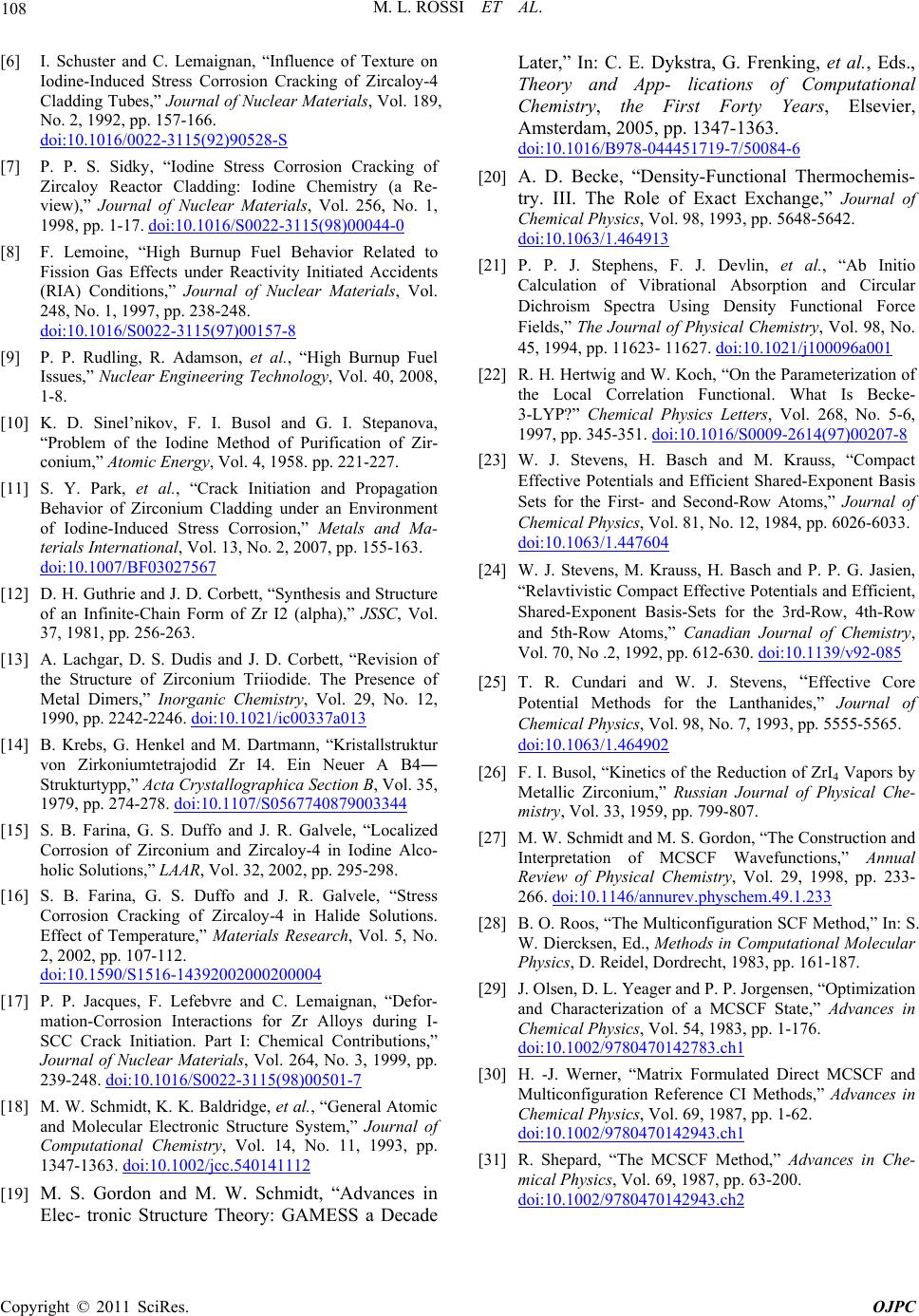
M. L. ROSSI ET AL.
Copyright © 2011 SciRes. OJPC
108
[6] I. Schuster and C. Lemaignan, “Influence of Texture on
Iodine-Induced Stress Corrosion Cracking of Zircaloy-4
Cladding Tubes,” Journal of Nuclear Materials, Vol. 189,
No. 2, 1992, pp. 157-166.
doi:10.1016/0022-3115(92)90528-S
[7] P. P. S. Sidky, “Iodine Stress Corrosion Cracking of
Zircaloy Reactor Cladding: Iodine Chemistry (a Re-
view),” Journal of Nuclear Materials, Vol. 256, No. 1,
1998, pp. 1-17. doi:10.1016/S0022-3115(98)00044-0
[8] F. Lemoine, “High Burnup Fuel Behavior Related to
Fission Gas Effects under Reactivity Initiated Accidents
(RIA) Conditions,” Journal of Nuclear Materials, Vol.
248, No. 1, 1997, pp. 238-248.
doi:10.1016/S0022-3115(97)00157-8
[9] P. P. Rudling, R. Adamson, et al., “High Burnup Fuel
Issues,” Nuclear Engineering Technology, Vol. 40, 2008,
1-8.
[10] K. D. Sinel’nikov, F. I. Busol and G. I. Stepanova,
“Problem of the Iodine Method of Purification of Zir-
conium,” Atomic Energy, Vol. 4, 1958. pp. 221-227.
[11] S. Y. Park, et al., “Crack Initiation and Propagation
Behavior of Zirconium Cladding under an Environment
of Iodine-Induced Stress Corrosion,” Metals and Ma-
terials International, Vol. 13, No. 2, 2007, pp. 155-163.
doi:10.1007/BF03027567
[12] D. H. Guthrie and J. D. Corbett, “Synthesis and Structure
of an Infinite-Chain Form of Zr I2 (alpha),” JSSC, Vol.
37, 1981, pp. 256-263.
[13] A. Lachgar, D. S. Dudis and J. D. Corbett, “Revision of
the Structure of Zirconium Triiodide. The Presence of
Metal Dimers,” Inorganic Chemistry, Vol. 29, No. 12,
1990, pp. 2242-2246. doi:10.1021/ic00337a013
[14] B. Krebs, G. Henkel and M. Dartmann, “Kristallstruktur
von Zirkoniumtetrajodid Zr I4. Ein Neuer A B4―
Strukturtypp,” Acta Crystallographica Section B, Vol. 35,
1979, pp. 274-278. doi:10.1107/S0567740879003344
[15] S. B. Farina, G. S. Duffo and J. R. Galvele, “Localized
Corrosion of Zirconium and Zircaloy-4 in Iodine Alco-
holic Solutions,” LAAR, Vol. 32, 2002, pp. 295-298.
[16] S. B. Farina, G. S. Duffo and J. R. Galvele, “Stress
Corrosion Cracking of Zircaloy-4 in Halide Solutions.
Effect of Temperature,” Materials Research, Vol. 5, No.
2, 2002, pp. 107-112.
doi:10.1590/S1516-14392002000200004
[17] P. P. Jacques, F. Lefebvre and C. Lemaignan, “Defor-
mation-Corrosion Interactions for Zr Alloys during I-
SCC Crack Initiation. Part I: Chemical Contributions,”
Journal of Nuclear Materials, Vol. 264, No. 3, 1999, pp.
239-248. doi:10.1016/S0022-3115(98)00501-7
[18] M. W. Schmidt, K. K. Baldridge, et al., “General Atomic
and Molecular Electronic Structure System,” Journal of
Computational Chemistry, Vol. 14, No. 11, 1993, pp.
1347-1363. doi:10.1002/jcc.540141112
[19] M. S. Gordon and M. W. Schmidt, “Advances in
Elec- tronic Structure Theory: GAMESS a Decade
Later,” In: C. E. Dykstra, G. Frenking, et al., Eds.,
Theory and App- lications of Computational
Chemistry, the First Forty Years, Elsevier,
Amsterdam, 2005, pp. 1347-1363.
doi:10.1016/B978-044451719-7/50084-6
[20] A. D. Becke, “Density-Functional Thermochemis-
try. III. The Role of Exact Exchang e, ” Journal of
Chemical Physics, Vol. 98, 1993, pp. 5648-5642.
doi:10.1063/1.464913
[21] P. P. J. Stephens, F. J. Devlin, et al., “Ab Initio
Calculation of Vibrational Absorption and Circular
Dichroism Spectra Using Density Functional Force
Fields,” The Journal of Physical Chemistry, Vol. 98, No.
45, 1994, pp. 11623- 11627. doi:10.1021/j100096a001
[22] R. H. Hertwig and W. Koch, “On the Parameterization of
the Local Correlation Functional. What Is Becke-
3-LYP?” Chemical Physics Letters, Vol. 268, No. 5-6,
1997, pp. 345-351. doi:10.1016/S0009-2614(97)00207-8
[23] W. J. Stevens, H. Basch and M. Krauss, “Compact
Effective Potentials and Efficient Shared-Exponent Basis
Sets for the First- and Second-Row Atoms,” Journal of
Chemical Physics, Vol. 81, No. 12, 1984, pp. 6026-6033.
doi:10.1063/1.447604
[24] W. J. Stevens, M. Krauss, H. Basch and P. P. G. Jasien,
“Relavtivistic Compact Effective Potentials and Efficient,
Shared-Exponent Basis-Sets for the 3rd-Row, 4th-Row
and 5th-Row Atoms,” Canadian Journal of Chemistry,
Vol. 70, No .2, 1992, pp. 612-630. doi:10.1139/v92-085
[25] T. R. Cundari and W. J. Stevens, “Effective Core
Potential Methods for the Lanthanides,” Journal of
Chemical Physics, Vol. 98, No. 7, 1993, pp. 5555-5565.
doi:10.1063/1.464902
[26] F. I. Busol, “Kinetics of the Reduction of ZrI4 Vapors by
Metallic Zirconium,” Russian Journal of Physical Che-
mistry, Vol. 33, 1959, pp. 799-807.
[27] M. W. Schmidt and M. S. Gordon, “The Construction and
Interpretation of MCSCF Wavefunctions,” Annual
Review of Physical Chemistry, Vol. 29, 1998, pp. 233-
266. doi:10.1146/annurev.physchem.49.1.233
[28] B. O. Roos, “The Multiconfiguration SCF Method,” In: S.
W. Diercksen, Ed., Methods in Computational Molecular
Physics, D. Reidel, Dordrecht, 1983, pp. 161-187.
[29] J. Olsen, D. L. Yeager and P. P. Jorgensen, “Optimization
and Characterization of a MCSCF State,” Advances in
Chemical Physics, Vol. 54, 1983, pp. 1-176.
doi:10.1002/9780470142783.ch1
[30] H. -J. Werner, “Matrix Formulated Direct MCSCF and
Multiconfiguration Reference CI Methods,” Advances in
Chemical Physics, Vol. 69, 1987, pp. 1-62.
doi:10.1002/9780470142943.ch1
[31] R. Shepard, “The MCSCF Method,” Advances in Che-
mical Physics, Vol. 69, 1987, pp. 63-200.
doi:10.1002/9780470142943.ch2